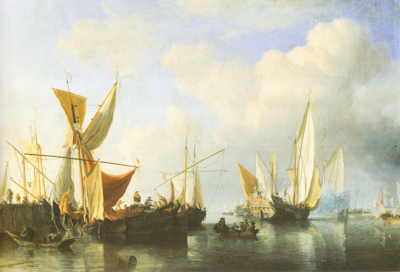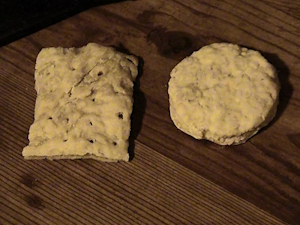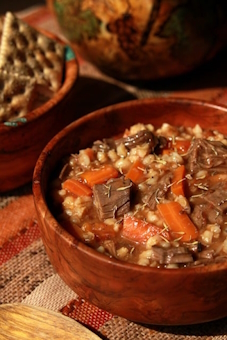 What did pirates eat? Anything they could get their hands on. Although fresh produce was scarce on long sea voyages, pirates didn’t usually spend as long at sea as the average sailor on a naval ship or merchantman. They would normally sail out from their base to seize there pray and return with their booty, where they could purchase fresh provisions. When no friendly port was available, food could be obtained by foraging on one of the many islands or even from plundering. After the fall of the pirate nest Nassau in 1718 and with the increasing pressure on pirates from the Royal Navy, their bases no longer existed and the sea rovers probably had to go for longer periods without fresh food.
What did pirates eat? Anything they could get their hands on. Although fresh produce was scarce on long sea voyages, pirates didn’t usually spend as long at sea as the average sailor on a naval ship or merchantman. They would normally sail out from their base to seize there pray and return with their booty, where they could purchase fresh provisions. When no friendly port was available, food could be obtained by foraging on one of the many islands or even from plundering. After the fall of the pirate nest Nassau in 1718 and with the increasing pressure on pirates from the Royal Navy, their bases no longer existed and the sea rovers probably had to go for longer periods without fresh food.
Meat and fish
At the outset of a journey fresh food such as meat, vegetables, fruit, milk and cheese would have been readily available, but after a couple of weeks the best of the food would have run out. When pirates first stocked up their ships before sailing, they often loaded livestock, namely chickens, pigs, goats, and cows on board, or, alternatively, they stole them. Cows were probably less frequent as they needed their own fodder and a great deal of water. The other animals would generally eat anything they were given. They used the chickens for their eggs and the cows for dairy purposes, and as time went on and food stores dwindled, they would end up killing the animals and eating every part of them that they could. Then they would have to resort to the preserved meat, which didn’t taste particularly good and often required more preparation. Salted or cured beef and pork might not have looked or tasted very appetizing, but it was essential for long voyages. It was often so hard it had to be softened before it could be consumed. Another way of preserving beef was to pickle it in vinegar.
 Another source of meat abundant in the Caribbean was turtle meat. Since adult turtles weigh between 300-350 pounds on average, the aquatic animals simply made for an enormously bountiful food source. The tender meat tasted like chicken and was often salted for later consumption, and their fat was made into oil for cooking. The buccaneer and author Alexander Exquemelin wrote that eating too much can make the skin greasy. Manatees, known then as sea cows, were also consumed and were said to have tasted like beef. No creature seemed to be safe from the hungry clutches of the sea rovers, being know to have at some point eaten all of the following: seals, sea lions, horses, sharks, monkeys, dolphins, penguins and other birds, even alligators and crocodiles. Out of desperation, they ate anything that was halfway palatable.
Another source of meat abundant in the Caribbean was turtle meat. Since adult turtles weigh between 300-350 pounds on average, the aquatic animals simply made for an enormously bountiful food source. The tender meat tasted like chicken and was often salted for later consumption, and their fat was made into oil for cooking. The buccaneer and author Alexander Exquemelin wrote that eating too much can make the skin greasy. Manatees, known then as sea cows, were also consumed and were said to have tasted like beef. No creature seemed to be safe from the hungry clutches of the sea rovers, being know to have at some point eaten all of the following: seals, sea lions, horses, sharks, monkeys, dolphins, penguins and other birds, even alligators and crocodiles. Out of desperation, they ate anything that was halfway palatable.
Pirates usually didn’t fish as often as one would expect, as the ship was generally in constant motion. When anchored offshore or the wind was calm, they might have used the time to catch some fish, but because it was a time consuming task, which didn’t offer large yields with the primitive methods at their disposal, fish would have been more of a treat than a staple part of their diet. They might have preserved any fish they caught, bought, or plundered by salting or curing it for the voyage. For more information on pirates’ consumption of meat and fish watch the informative video Meat, fish, and proteins aboard a Pirate Ship on the Gold and Gunpowder YouTube channel.
Bread products
 Bread was another staple of all seamen. The term was used to cover all forms of flour-based products, including ship’s biscuit. Pirates were not known for baking their own, lacking facilities for making large quantities. The bread that pirates might have eaten was more like a cracker than the soft loaves of bread we are used to. The hard bread has been unappetizingly described as “fearsomely durable squares of flour-and-water dough,” and was by the beginning of the 19th century better known as hard tack. This product kept for a lot longer than other forms of bread. They were usually made from wheat flour, water, salt or sugar, and bran. The dough was baked 2-4 times making it hard. It would normally be dipped in a drink or stew to soften it up, or it could be crushed into a meal. On long voyages, this hard bread often became infested with weevils, making them nearly inedible. It maybe doesn’t need saying, but ship’s biscuit wasn’t too popular among pirates. An alternative was rusk, made of fine wheat flour baked like a biscuit, but not as hard as ship’s biscuit. The pirates would only eat soft bread if they could obtain it somewhere on land. Sea rovers enjoyed dumplings, known as doughboys, made of flour and suet, which could be both sweet or savoury. These doughboys were boiled or fried in oil or lard and eaten with butter, lard, or oil. They were unsurprisingly preferred to ship’s biscuit by pirates. Maize, which was plentiful in the Spanish colonies, was used for tortillas or porridge. For more information on pirates’ consumption of bread products watch the informative video Bread aboard a Pirate Ship on the Gold and Gunpowder YouTube channel.
Bread was another staple of all seamen. The term was used to cover all forms of flour-based products, including ship’s biscuit. Pirates were not known for baking their own, lacking facilities for making large quantities. The bread that pirates might have eaten was more like a cracker than the soft loaves of bread we are used to. The hard bread has been unappetizingly described as “fearsomely durable squares of flour-and-water dough,” and was by the beginning of the 19th century better known as hard tack. This product kept for a lot longer than other forms of bread. They were usually made from wheat flour, water, salt or sugar, and bran. The dough was baked 2-4 times making it hard. It would normally be dipped in a drink or stew to soften it up, or it could be crushed into a meal. On long voyages, this hard bread often became infested with weevils, making them nearly inedible. It maybe doesn’t need saying, but ship’s biscuit wasn’t too popular among pirates. An alternative was rusk, made of fine wheat flour baked like a biscuit, but not as hard as ship’s biscuit. The pirates would only eat soft bread if they could obtain it somewhere on land. Sea rovers enjoyed dumplings, known as doughboys, made of flour and suet, which could be both sweet or savoury. These doughboys were boiled or fried in oil or lard and eaten with butter, lard, or oil. They were unsurprisingly preferred to ship’s biscuit by pirates. Maize, which was plentiful in the Spanish colonies, was used for tortillas or porridge. For more information on pirates’ consumption of bread products watch the informative video Bread aboard a Pirate Ship on the Gold and Gunpowder YouTube channel.
Fruit and vegetables
Fresh fruit and vegetables didn’t keep long on lengthy journeys, but as pirates, at least until 1718, often didn’t sail too far, they could usually get their hands on them. Vegetables were often pickled for preservation. They enjoyed much fresh produce that was deemed exotic at the time. Coconuts and bananas were popular, and avocados were often used to make guacamole. Plantains could be eaten as a substitute for bread, both boiled or roasted, or were eaten as a mash, depending on the ripeness. Cassava was often made into flour, while potatoes and yams were grown all over the Americas. Tomatoes were popular among the Spanish, although less popular in Britain, where they were deemed to be poisonous until as late as the mid-18th century. Mangos were introduced to the Americas from south-east Asia in the 1700s and were savoured for their sweet, creamy flavour, and their consumption helped to battle scurvy, as did that of lime, which was plentiful in the region and a popular ingredient.
When dried, beans, chick peas, and peas lasted for a long time. They were used in soups and stews. Rice was plentiful in the Americas and was boiled in water or coconut milk and then squeezed dry. It was very common among the Madagascan pirates. When on land pirates could also gather wild vegetables, such as wild celery, turnip-greens, water-cress, and tree cabbage to put in their stews. For more information on pirates’ consumption of fruit and vegetables watch the informative video How Pirates Battled Scurvy on the Gold and Gunpowder YouTube channel.
Meals
 Soups and stews with varying ingredients were a popular meal for mariners. One particular dish, burgoo, was a popular meal on board ships. It was made from oats, bran, grains, and flour. Butter and sugar could be added to make a kind of porridge, or it could be eaten as a savoury dish with meat or fish. It was less common in the Caribbean unless the pirates manage to loot some oats. One of the most popular dishes among pirates was salmagundi, which according to David Reinhardt, author of his 1997 book Pirates and Piracy, could include: “Turtle meat, fish, pork, chicken, corned beef, ham, duck and pigeon. The meats would be roasted, chopped into pieces and marinated in spiced wine, then mixed with cabbage, anchovies, pickled herring, mangoes, hard-boiled eggs, palm hearts, onions, olives, grapes and any other pickled vegetable available. The entire concoction would then be highly seasoned with garlic, salt, pepper, and mustard seed and soaked with oil and vinegar.” A lot of seasoning, such as pepper and allspice, would hide the unpleasant taste of any ingredients that were less than fresh. Herbs and spices generally made the food taste better, and pirate cooks apparently heavily flavoured their meals this way. Food could also be complimented with a variety of sauces containing spices, salt, lime, olive oil, garlic, or vinegar.
Soups and stews with varying ingredients were a popular meal for mariners. One particular dish, burgoo, was a popular meal on board ships. It was made from oats, bran, grains, and flour. Butter and sugar could be added to make a kind of porridge, or it could be eaten as a savoury dish with meat or fish. It was less common in the Caribbean unless the pirates manage to loot some oats. One of the most popular dishes among pirates was salmagundi, which according to David Reinhardt, author of his 1997 book Pirates and Piracy, could include: “Turtle meat, fish, pork, chicken, corned beef, ham, duck and pigeon. The meats would be roasted, chopped into pieces and marinated in spiced wine, then mixed with cabbage, anchovies, pickled herring, mangoes, hard-boiled eggs, palm hearts, onions, olives, grapes and any other pickled vegetable available. The entire concoction would then be highly seasoned with garlic, salt, pepper, and mustard seed and soaked with oil and vinegar.” A lot of seasoning, such as pepper and allspice, would hide the unpleasant taste of any ingredients that were less than fresh. Herbs and spices generally made the food taste better, and pirate cooks apparently heavily flavoured their meals this way. Food could also be complimented with a variety of sauces containing spices, salt, lime, olive oil, garlic, or vinegar.
Sweets
Sugar was cheap in New World. It was available in solid loaves and not granulated as it is today. The sugar cane was crushed and its juices boiled and hardened in moulds. The required sugar was scraped or snapped from the loaf. Candies, in those days called sweetmeats, were very popular. Marmalade, which, in those days, was a sold, jelly like candy was eagerly consumed. Molasses could be used as a spread, although it was primarily used in the production of rum. Hot chocolate was very popular in Europe and the Americas at the time, which was ground to powder and boiled with sugar and spices. It was often drunk for breakfast. For more information on pirate’s consumption of sweets watch the informative video Pirates loved candy on the Gold and Gunpowder YouTube channel.
Dietary health problems
While pirates had their safe havens and didn’t need to venture far to capture their prey, they generally enjoyed a healthy diet, albeit sometimes with too much sugar. Due to the limited availability of fruits and vegetables during long journeys, seamen often grappled with malnutrition and scurvy due to vitamin C deficiency. Consequently, scurvy was a widespread issue among sailors, resulting in a variety of symptoms like swollen and bleeding gums, loosened teeth, stinking breath, pain the joints, sores, and mood swings. The disease usually proved fatal if the afflicted didn’t obtain an intake of vitamin C before it was too late. For more information on scurvy watch the informative video The Nightmare Disease that Terrified Pirates… on the Walk the Plank YouTube channel.
